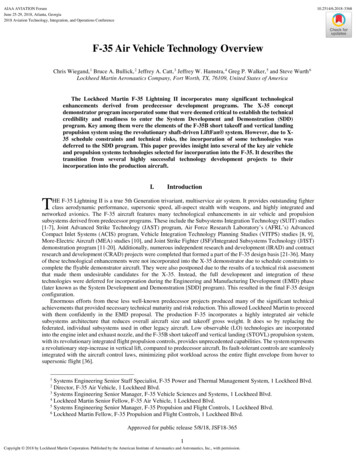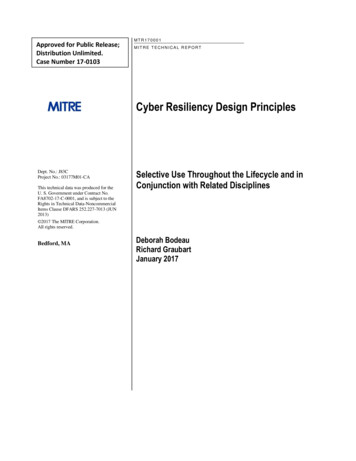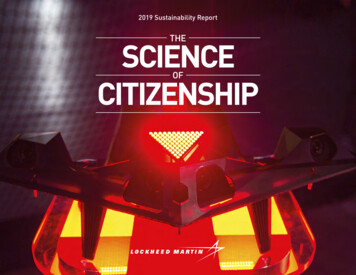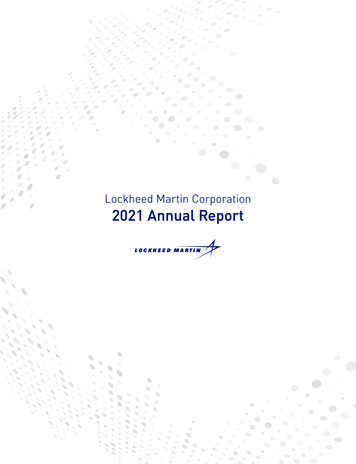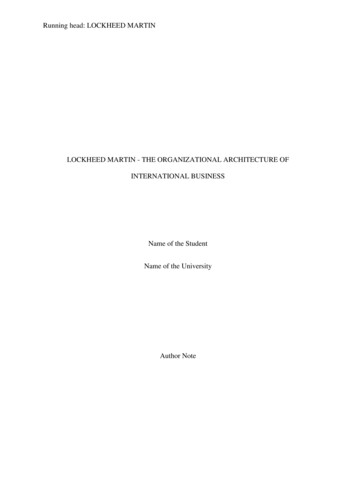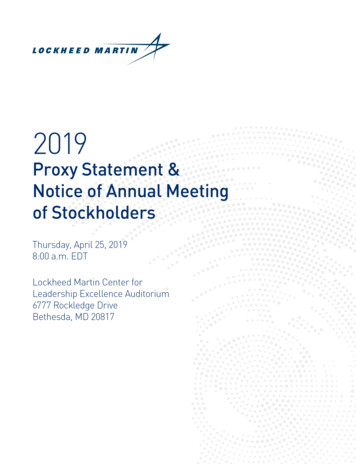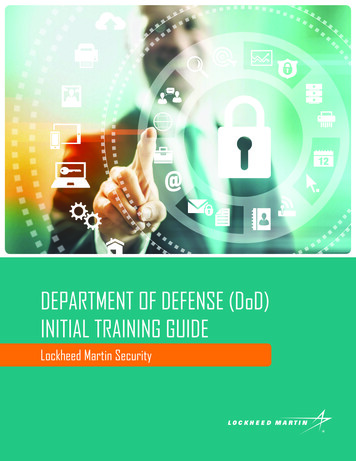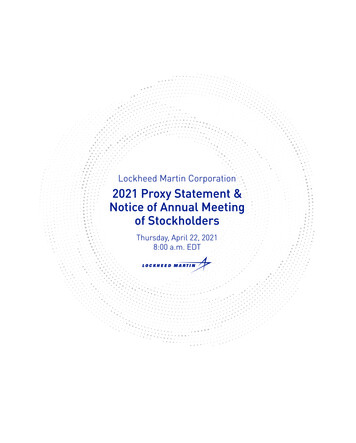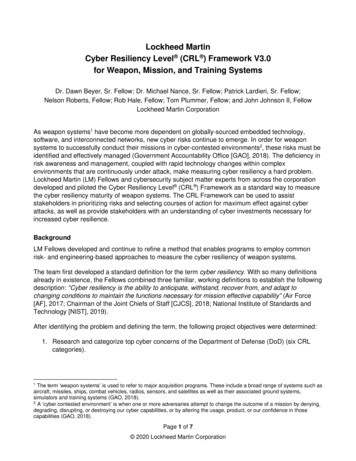
Transcription
Lockheed MartinCyber Resiliency Level (CRL ) Framework V3.0for Weapon, Mission, and Training SystemsDr. Dawn Beyer, Sr. Fellow; Dr. Michael Nance, Sr. Fellow; Patrick Lardieri, Sr. Fellow;Nelson Roberts, Fellow; Rob Hale, Fellow; Tom Plummer, Fellow; and John Johnson II, FellowLockheed Martin CorporationAs weapon systems1 have become more dependent on globally-sourced embedded technology,software, and interconnected networks, new cyber risks continue to emerge. In order for weaponsystems to successfully conduct their missions in cyber-contested environments2, these risks must beidentified and effectively managed (Government Accountability Office [GAO], 2018). The deficiency inrisk awareness and management, coupled with rapid technology changes within complexenvironments that are continuously under attack, make measuring cyber resiliency a hard problem.Lockheed Martin (LM) Fellows and cybersecurity subject matter experts from across the corporationdeveloped and piloted the Cyber Resiliency Level (CRL ) Framework as a standard way to measurethe cyber resiliency maturity of weapon systems. The CRL Framework can be used to assiststakeholders in prioritizing risks and selecting courses of action for maximum effect against cyberattacks, as well as provide stakeholders with an understanding of cyber investments necessary forincreased cyber resilience.BackgroundLM Fellows developed and continue to refine a method that enables programs to employ commonrisk- and engineering-based approaches to measure the cyber resiliency of weapon systems.The team first developed a standard definition for the term cyber resiliency. With so many definitionsalready in existence, the Fellows combined three familiar, working definitions to establish the followingdescription: “Cyber resiliency is the ability to anticipate, withstand, recover from, and adapt tochanging conditions to maintain the functions necessary for mission effective capability” (Air Force[AF], 2017; Chairman of the Joint Chiefs of Staff [CJCS], 2018; National Institute of Standards andTechnology [NIST], 2019).After identifying the problem and defining the term, the following project objectives were determined:1. Research and categorize top cyber concerns of the Department of Defense (DoD) (six CRLcategories).The term ‘weapon systems’ is used to refer to major acquisition programs. These include a broad range of systems such asaircraft, missiles, ships, combat vehicles, radios, sensors, and satellites as well as their associated ground systems,simulators and training systems (GAO, 2018).2 A ‘cyber contested environment’ is when one or more adversaries attempt to change the outcome of a mission by denying,degrading, disrupting, or destroying our cyber capabilities, or by altering the usage, product, or our confidence in thosecapabilities (GAO, 2018).1Page 1 of 7 2020 Lockheed Martin Corporation
2. Develop a conceptual model (CRL Framework; see Figure 1) and describe the categories,levels, and criteria (CRL Guidebooks).3. Identify and define levels of increasing resiliency (CRL maturity level descriptions; see Figure2).4. Identify the qualitative and quantitative cyber performance measures for each category level(Cyber Resiliency Scoreboard (CRS)).Figure 1. Cyber Resiliency Level Framework V3.0OverviewThe CRL includes the framework (see Figure 1), guidebooks, maturity levels and descriptions (seeFigure 2), and the CRS which contribute to the evaluation of resiliency across six categories. Thesesix categories form the major recurring concerns of the DoD and were pulled from across theirstrategy, policies, practices, testimonies, and conference proceedings. An overview of each categoryis provided below:1. Visibility – ability to sense, collect, and fuse data to inform defense and response2. Cyber Hygiene – ability to manage the most common and pervasive cyber risks throughout thelife cycle3. Requirements – ability to identify, analyze, and define specifications commensurate withmission importance, risk, and the operational environment4. Test and Evaluation – ability to measure the effectiveness of controls against missionobjectives5. Architecture – ability to maintain capability against cyber attacksPage 2 of 7 2020 Lockheed Martin Corporation
6. Information Sharing – ability to share timely cyber threat information and defensive measuresto improve the cyber defensive postureEach category is split into four levels of increasing maturity: CRL 1 – Ad-hoc, CRL 2 – Managed, CRL3 – Optimized, and CRL 4 – Adaptive (see Figure 2).Figure 2. CRL maturity level descriptionsUsageThe CRL can be used in any phase of the acquisition life cycle, concept to sunset, and—dependingon the scope of the assessment—in any environment, such as development, manufacturing,operations, and supply chain. The processes and practices to perform each step are specified in theguidebooks and the CRS.The CRL embraces the following four steps (Defense Science Board [DSB], 2016):1. Identify level of cyber resiliency that currently exists and/or is planned.2. Assess cyber risk.Page 3 of 7 2020 Lockheed Martin Corporation
3. Identify relationships between cyber investments and amount of increased resilience to attack.4. Prioritize recommendations for cyber investment.Step 1: Identify level of cyber resiliency that currently exists and/or is planned.The purpose of this step is to leverage the criteria outlined in the guidebooks and the performancemeasures delineated in the CRS to evaluate the CRL of the weapon system. The CRS is ameasurement tool which consists of a questionnaire and dashboard. The questionnaire providesqualitative and quantitative cyber performance measures based on category criteria. Thequestionnaire responses are used for the back-end analysis and represented via a dashboard. Thedashboard consists of data sets and graphs that can be leveraged to assist stakeholders in measuringthe resiliency that currently exists and/or is planned.Requirements and/or controls are correlated to a category and evaluated against category criteria andperformance measures. A CRL measurement is provided for each individual category. The resultingmeasurement of categories is expressed using a radar chart (see Figure 3). Results from this stepgive stakeholders improved insight into the level of cyber resiliency that currently exists and/or isplanned.Figure 3. CRL – Step 1Determining what products provide useful data to measure the CRL in Step 1 depends on the phase,within the acquisition cycle, the team is in at the time of assessment. For example, if the team is in theproposal phase, they can use the requirements outlined in the statement of work; if in planning, theteam can utilize the concept of operations; if in development, the team can leverage the requirementsand design documents; if in operations, the team can assess controls called out in engineering andsystem documentation, existing risk matrices, and assessment results.Step 2: Assess cyber risk.The purpose of this step is to assess the overall risk of the weapon system. Step 1 measures overallcyber resiliency mechanisms in place. Step 2 uses that information in combination with informationfrom other sources and assessment methods to perform a risk assessment. The assessment step isused to identify, analyze, and prioritize risk (NIST, 2011). The team should leverage stakeholders’input in prioritizing risk.To perform Step 2, the CRL endorses multiple assessment methods including NIST’s RiskManagement Process, DoD’s Cyber Table Top (CTT), LM’s Intelligence Driven Defense , penetrationtesting, vulnerability scans, etc. In the example outlined in Figure 6, DoD’s CTT is used.Page 4 of 7 2020 Lockheed Martin Corporation
Figure 4. CRL – Step 2Step 3: Identify relationships between cyber investments and amount of increased resilience toattack.The purpose of this step is for stakeholders to use prioritized risks to identify and evaluate courses ofaction (CoA) (NIST, 2011). The CRS and the processes outlined in the guidebooks are used toidentify and evaluate candidate CoAs. A cost-benefit analysis is performed to estimate CoA strengthsand weaknesses to determine which CoA will provide the best approach to achieving estimatedbenefits, preserving cost, and mitigating risks while increasing resiliency (see Figure 5).Figure 5. CRL – Step 3Step 4: Prioritize recommendations for cyber investment.In Step 4, the evaluation team collaborates with stakeholders to prioritize and select CoAs. The teamcompares selected CoAs to the criteria delineated in the CRS to identify category levels. Results arepresented to stakeholders via a radar chart (see Figure 6) to provide visualization comparisonbetween as-is results and to-be recommendations.Figure 6. CRL – Step 4CoAs then transition into controls that are defined by requirements and architecture concepts.Leveraging existing systems’ engineering and risk management processes, controls along withcost/benefit analysis, schedule, and technical baseline impacts are reviewed and approved bystakeholders. From design through test, the selected controls are integrated into the technical solutionand corresponding requirements are verified.Page 5 of 7 2020 Lockheed Martin Corporation
Repeat Step 2 (as required):After controls are integrated into the operational environment, stakeholders can decide to do anotherassessment (see Figure 7) to validate the effectiveness of controls and leverage the radar chart, forthe third time, to display the actual level of protection.Figure 7. CRL – Repeat Step 2LM CRL and DoD CMMCThe LM CRL and the DoD’s Cybersecurity Maturity Model Certification (CMMC) are independent withdifferent purposes yet complement each other when assessing tactical to strategic risk. The CRLfocuses on weapon systems to include the related equipment, materials, services, personnel, andmeans of delivery and deployment required for self sufficiency. The CMMC focuses on cybersecurityassessment of enterprise networks and Controlled Unclassified Information as it flows throughoutprogram multitiered supply chains. Both the CRL and CMMC, when leveraged together, can provide amultitiered (organization, mission/business, and information system) risk management approach.SummaryThe Lockheed Martin Cyber Resiliency Level (CRL ) Framework is used to measure the cyberresiliency maturity of a weapon system. CRL can be leveraged in any phase of the acquisition lifecycle and—depending on the scope of the assessment—in any environment, such as development,manufacturing, operations, and supply chain. The CRL allows stakeholders to prioritize and selectsolutions for maximum effect against cyber attacks and provides stakeholders with an understandingof cyber investments necessary for increased cyber resilience. CRL products include a structuredframework (see Figure 1), maturity levels and descriptions (see Figure 2), guidebooks, and the CRS.Since 2018, the project team has used new research, lessons learned, and stakeholder feedbackfrom several program pilots and customer engagements across all business areas to build andtransform CRL artifacts. Recent changes included updates to the Framework and the Criteria,Measures, and Measurements (CMM) workbook. Within the Framework, version 3.0, the Architecturecategory (see Figure 1) levels were changed to: CRL 1 – Exposed, CRL 2 – Hardened, CRL 3 –Threat-Resilient, and CRL 4 – Self-Healing. The CMM workbook transitioned to the CRS, whichstreamlined the measurement process by making it more simplistic, understandable, and easier todiscuss with stakeholders.LM continues to collect, assess, and disposition program feedback to mature the framework,guidebooks, and CRS, and to shape processes, practices, and training.Page 6 of 7 2020 Lockheed Martin Corporation
AcknowledgementsLM Fellows, Rising Technical Talent, and the Cyber Senior Advisory Board provided valuable subjectmatter expertise, guidance, and leadership. The CRL Category Leads, CRL Change Control Board,Program Stakeholders, and the CRS product team provided significant contributions to CRL Version3.0. The CRL Architecture category level changes were led by Ethan Puchaty. The CMM workbook toCRS transformation was led by Jacquelyn Blanchard and Orion Strimenos.ReferencesAF. (2017). Cyber Resiliency Office for Weapon Systems briefing.CJCS. (2018). Joint Publication 3-14. Space s/Doctrine/pubs/jp3 14.pdfDSB. (2016). DSB Task Force Report on Cyber Defense u2/1023639.pdfGAO. (2018). GAO-19-128: Weapon Systems Cybersecurity: DoD Just Beginning to Grapple withScale of Vulnerabilities. https://www.gao.gov/assets/700/694913.pdfNIST. (2011). NIST SP 800-39, Managing Information Security Risk: Organization, Mission, andInformation System View. ecialpublication80039.pdfNIST. (2019). NIST SP 800-160V2, Developing Cyber Resilient Systems: A Systems SecurityEngineering Approach. ons/NIST.SP.800-160v2.pdfPage 7 of 7 2020 Lockheed Martin Corporation
Step 1: Identify level of cyber resiliency that currently exists and/or is planned. The purpose of this step is to leverage the criteria outlined in the guidebooks and the performance measures delineated in the CRS to evaluate the CRL of the weapon system. The CRS is a measurement tool which consists of a questionnaire and dashboard.
